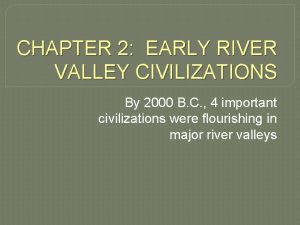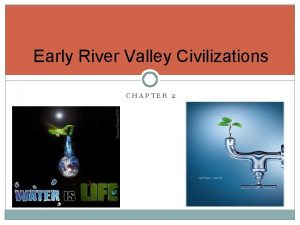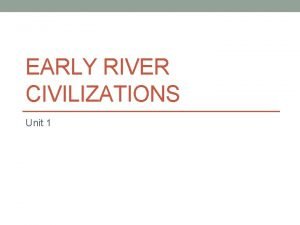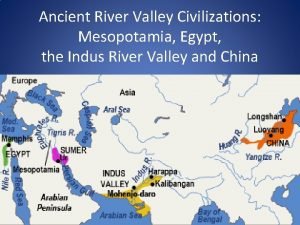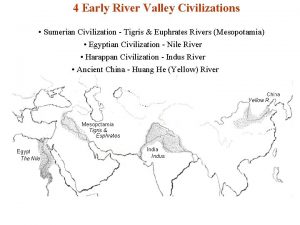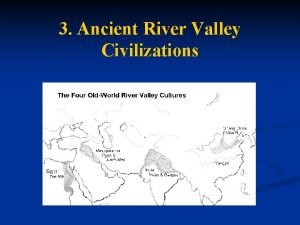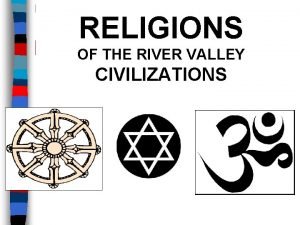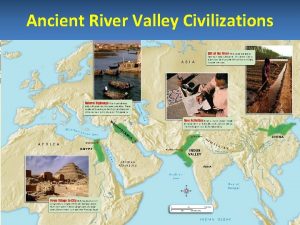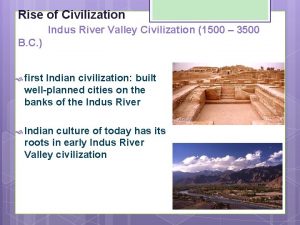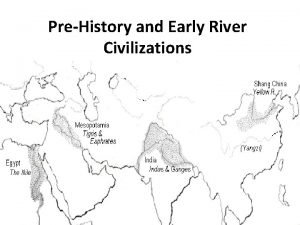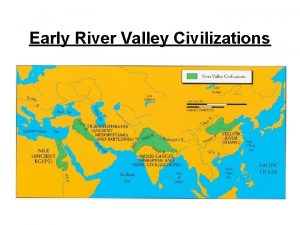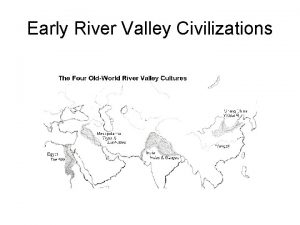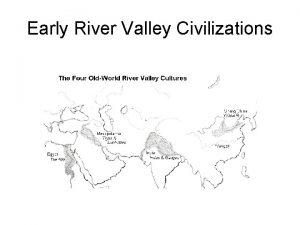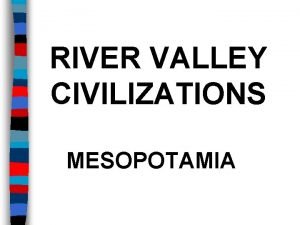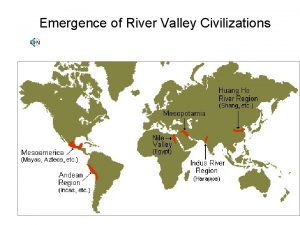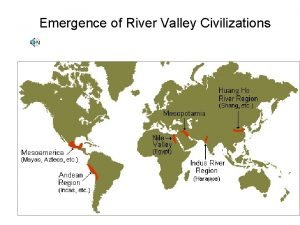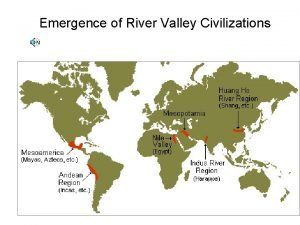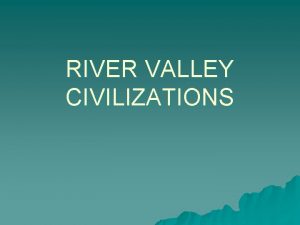Chapter 2 Early River Valley Civilizations Early Civilizations


![Other early civilizations (about 2000 to 500 B. C. [B. C. E. ]) • Other early civilizations (about 2000 to 500 B. C. [B. C. E. ]) •](https://slidetodoc.com/presentation_image_h2/adf3d879ca25cc44508c0d0e6c692ee5/image-3.jpg)








- Slides: 11

Chapter 2 Early River Valley Civilizations

Early Civilizations River valley civilizations (about 3500 to 500 B. C. [B. C. E. ]) • Mesopotamian civilization: Tigris and Euphrates River Valleys (Southwest Asia) • Egyptian civilization: Nile River Valley and Nile Delta (Africa) • Indian civilization: Indus River Valley (South Asia) • Chinese civilization: Huang He Valley (East Asia) These river valleys offered rich soil and irrigation water for agriculture, and they tended to be in locations easily protected from invasion by nomadic peoples.
![Other early civilizations about 2000 to 500 B C B C E Other early civilizations (about 2000 to 500 B. C. [B. C. E. ]) •](https://slidetodoc.com/presentation_image_h2/adf3d879ca25cc44508c0d0e6c692ee5/image-3.jpg)
Other early civilizations (about 2000 to 500 B. C. [B. C. E. ]) • Hebrews settled between the Mediterranean Sea and the Jordan River Valley (part of Fertile Crescent in Southwest Asia). • Phoenicians settled along the Mediterranean coast (part of Fertile Crescent in Southwest Asia). • Nubia was located on the upper (southern) Nile River (Africa).

Patterns Development of social patterns • Hereditary rulers: Dynasties of kings, pharaohs • Rigid class system where slavery was accepted Development of political patterns • World’s first states (i. e. , city-states, kingdoms, empires) • Centralized government, often based on religious authority • Written law codes (e. g. , Ten Commandments, Code of Hammurabi)

• • • Development of economic patterns Use of metal (e. g. , bronze, iron) tools and weapons Increasing agricultural surplus: Better tools, plows, irrigation Increasing trade along rivers and by sea (Phoenicians) Development of the world’s first cities Development of the practice of slavery within most cultures in the ancient world, taking various forms

Religion • Polytheism was practiced by most early civilizations. • Monotheism was practiced by the Hebrews. Origins of Judaism • Abraham • Moses • Jerusalem Beliefs, traditions, and customs of Judaism • Belief in one God (monotheism) • Torah, which contains the written records and beliefs of the Jews • Ten Commandments, which state moral and religious conduct Spread of Judaism • Exile • Diaspora

Language & Writing • • Pictograms: Earliest written symbols Hieroglyphics: Egypt Cuneiform: Sumer Alphabet: Phoenicia

Egypt Vocab 1. Shadoof—A machine used to lifet water from the Nile to the basins 2. Pharaoh—Egyptian Kings 3. Pyramids—Tombs for the pharaoh that serves as a gateway to the afterlife 4. Embalming—A method of preserving bodies for the afterlife 5. Mummy—A wrapped body of a pharaoh 6. Legend—A list of symbols and what they stand for 7. Hieroglyphic—A kind of writing in which pictures represent words/sounds 8. Papyrus—Paper made from the reeds of plants

Section 1: The Nile 1. The Nile was the region of Africa in which its first civilizations developed. This civilization was called Egypt. 2. The people settled along the Delta regions of the Nile where the land was fertile. 3. Along the Nile, Egyptians dug holes called basins. These holes were filled with water in which a shadoof could carry water to the crops.

Section 2: India 1. Eastern River Valley civilization began along the Indus River around 2500 BCE. 2. The first people to establish a civilization in the Indus River valley were the Harappans. 3. The Harappans controlled the Indus River as a means of fertilizing their crops. 4. The Harappans are believed to be the first people to grow cotton, weave it into cloth, and developed planned communities. 5. The oldest cities in the Indus Valley were Harappa and Mohenjo-Daro. 6. Around 1200 BCE, the Aryans took control of the valley. 7. They brought an ancient language called Sanskrit.

Section 3: China 1. The Chinese kingdom began with the legendary kingdom of Xia. 2. This civilization settled along the Huang Ho River around 2000 BCE. 3. Not much is known about the Xia, but historians believe they chose this river because its floods left the land very fertile. 4. Due to the ferocity of floods and the color of the water, the Huang Ho River had two other names, Yellow River and China’s Sorrow. 5. The first recorded Chinese dynasty was the Shang. 6. The Shangs developed China’s oldest known written language. This language was found written on oracle bones. 7. The Shang dynasty flourished because of their ability to make bronze weapons. 8. However, the dynasty came to an end with Zhou invasion in 1122 BCE.
 River valley civilizations def
River valley civilizations def Chapter 2 early river valley civilizations
Chapter 2 early river valley civilizations Ancient river valley civilizations map
Ancient river valley civilizations map Ancient river valleys map
Ancient river valleys map 4 river valley civilizations
4 river valley civilizations River valley civilizations map
River valley civilizations map 4 river valley civilizations
4 river valley civilizations Slidetodoc.com
Slidetodoc.com Civilization ppt template
Civilization ppt template River valley civilizations
River valley civilizations River valley civilizations map
River valley civilizations map River valley civilizations vocabulary
River valley civilizations vocabulary
